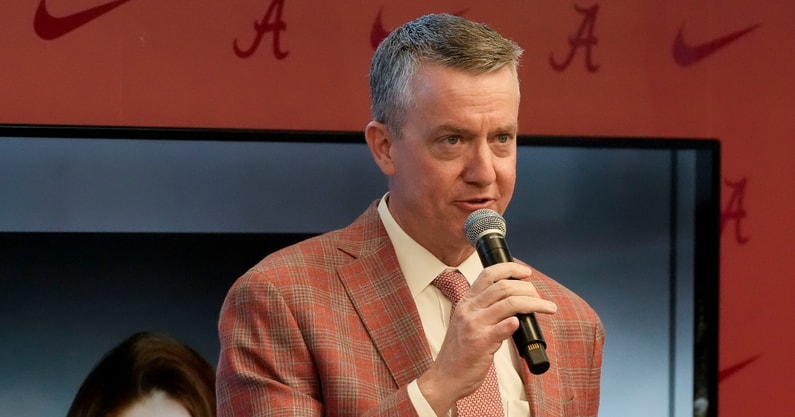Greg Byrne Expects Alabama to Fully Fund Athlete Revenue‑Share and Scholarships, Likely Allocating Majority to Football and Basketball While Supporting Title IX and Non‑Revenue Sports
Alabama athletic director Greg Byrne has mapped out how the Crimson Tide will allocate its revenue‑sharing funds following the upcoming House vs. NCAA settlement, which permits Power Four schools to share up to $20.5 million annually—rising over time—with student‑athletes Byrn.e’s approach reflects both strategic financial planning and a commitment to sustaining Alabama’s legendary athletic success across men’s and women’s sports. Here’s a detailed breakdown of Byrne’s vision for dividing that revenue—and how the department intends to balance elite performance with broad-based opportunity.
Byrne’s commentary highlights the scale of this shift: the revenue‑sharing obligation will cost “a projected $20.5 million” annually, essential for compliance with the settlement . Alabama will “fully fund revenue sharing,” meaning the athletic department intends to allocate that entire pool to student‑athletes .
While Byrne did not specify exact percentages, he explained that, “most power conference programs are preparing to commit 90% of the pool to football and men’s basketball” . It is reasonable to expect Alabama will adopt a similar allocation, given football’s central role in fueling the department’s budget and basketball’s status as a strong revenue generator . Byrne’s comments underscore this strategic priority: “We’re not going to stop investing in football… because of the impact it makes on everything else”.
Even so, Byrne emphasized that Alabama’s plan will not neglect non‑revenue sports or Title IX compliance. The department is working to balance economic realities with an inclusive vision: “We’ve got to balance Title IX with that” when adding scholarships and distributing revenue. While half of any new scholarship funds—or revenue‑share allocations—must support women’s sports, Byrne made clear that Alabama values all athletics equally: “We don’t have a sport here at the University of Alabama just to have a sport” .
In addition to revenue‑share funding, Alabama plans to add approximately 40 new scholarships across its department. Byrne previously announced the intent to add scholarships, with Title IX mandating that about half must support women’s programs. Scholarship caps per sport have also shifted: football now allows up to 105 roster spots (with the SEC capping at 85 for 2025); men’s and women’s basketball are capped at 15; baseball at 34; soccer at 28; softball at 25; and volleyball at 18.
Byrne has also emphasized the department’s broader strategy: new revenue pathways and operational efficiency. He praised the creativity of Alabama’s staff in brainstorming “budget optimizations and new revenue opportunities,” particularly through Yea Alabama—the program’s NIL content platform. Yea Alabama will play a critical role in fan engagement and enhancing student‑athlete NIL opportunities via authentic, media‑driven content. The department benefits from a long-term multimedia rights deal with Learfield, generating over $16 million annually with built-in escalators.
Despite this optimism, Byrne acknowledges the financial strain. The athletic program has posted significant deficits—$12.1 million in FY 2023 and up to $40 million in some years—with revenues around $199.9 million against $212 million in expenses . Student-athlete spending in scholarship support, services, and facilities is estimated at roughly $187,000 per athlete per year .
Given those pressures, Byrne has appealed directly to fans for increased support toward NIL collectives. He described Alabama’s budget and competitive landscape as no different from other programs—one must “ask” to receive support. His message, calling upon fans to “fight back,” reflects urgency amid competition from schools offering “million‑dollar paydays” to lure athletes. While some fans criticized this approach—calling it “shaking down fans” —Byrne maintains that diversifying revenue sources through NIL collectives complements institutional funding and enables competitive alignment in the new era.
Byrne’s philosophy is institutionally bold yet strategically focused: to sustain Crimson Tide dominance while elevating all student-athletes across sports. Alabama intends to ensure the majority of NIL and revenue-share funds support the highest-profile programs, buttressed by systemic support for women’s and Olympic athletics. The success of this model will hinge on Alabama’s ability to grow new revenue, attract donor investment, and optimize operations—all while meeting legal and ethical standards in a rapidly changing collegiate landscape.
In the coming months, as the House vs. NCAA settlement takes full legal effect, Byrne’s plan will be tested. But if past trends hold, Alabama will continue to lean heavily on football and men’s basketball as its financial anchors, while using careful planning to extend competitive equity and Title IX compliance across its entire program. This model reflects a blended strategy: resource concentration on high-profile sports, coupled with a commitment to broaden opportunities and reinforce the Crimson Tide’s tradition of excellence.



